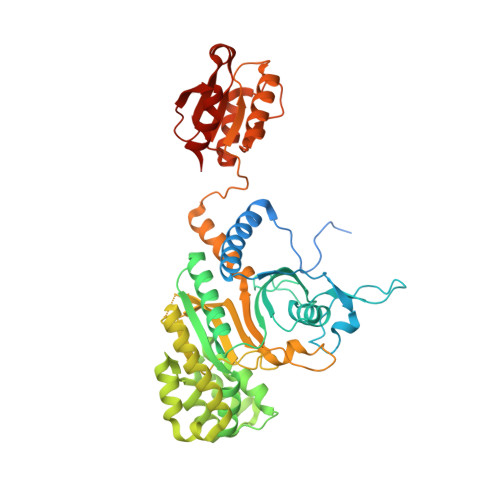CMT disease severity correlates with mutation-induced open conformation of histidyl-tRNA synthetase, not aminoacylation loss, in patient cells.
Blocquel, D., Sun, L., Matuszek, Z., Li, S., Weber, T., Kuhle, B., Kooi, G., Wei, N., Baets, J., Pan, T., Schimmel, P., Yang, X.L.(2019) Proc Natl Acad Sci U S A 116: 19440-19448
- PubMed: 31501329
- DOI: https://doi.org/10.1073/pnas.1908288116
- Primary Citation of Related Structures:
5W6M, 6O76 - PubMed Abstract:
Aminoacyl-transfer RNA (tRNA) synthetases (aaRSs) are the largest protein family causatively linked to neurodegenerative Charcot-Marie-Tooth (CMT) disease. Dominant mutations cause the disease, and studies of CMT disease-causing mutant glycyl-tRNA synthetase (GlyRS) and tyrosyl-tRNA synthetase (TyrRS) showed their mutations create neomorphic structures consistent with a gain-of-function mechanism. In contrast, based on a haploid yeast model, loss of aminoacylation function was reported for CMT disease mutants in histidyl-tRNA synthetase (HisRS). However, neither that nor prior work of any CMT disease-causing aaRS investigated the aminoacylation status of tRNAs in the cellular milieu of actual patients. Using an assay that interrogated aminoacylation levels in patient cells, we investigated a HisRS-linked CMT disease family with the most severe disease phenotype. Strikingly, no difference in charged tRNA levels between normal and diseased family members was found. In confirmation, recombinant versions of 4 other HisRS CMT disease-causing mutants showed no correlation between activity loss in vitro and severity of phenotype in vivo. Indeed, a mutation having the most detrimental impact on activity was associated with a mild disease phenotype. In further work, using 3 independent biophysical analyses, structural opening (relaxation) of mutant HisRSs at the dimer interface best correlated with disease severity. In fact, the HisRS mutation in the severely afflicted patient family caused the largest degree of structural relaxation. These data suggest that HisRS-linked CMT disease arises from open conformation-induced mechanisms distinct from loss of aminoacylation.
Organizational Affiliation:
Department of Molecular Medicine, The Scripps Research Institute, La Jolla, CA 92037.















